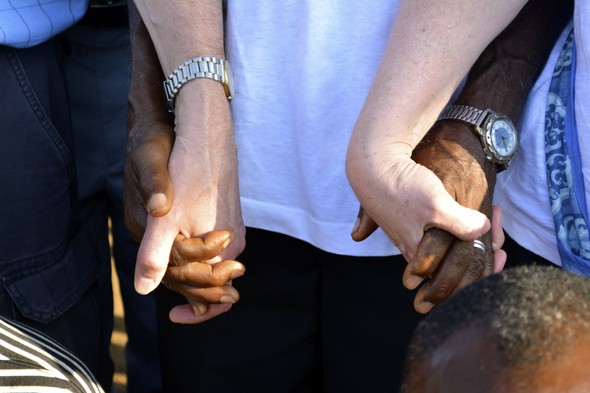By Cindy Corell, Mission Co-worker, Joining Hands Haiti

Members of a delegation of Presbyterian churches visiting our Joining Hands network in Haiti gather with farmers who have lost their land to a corporation. Photo credit: Cindy Corell
The cold-blooded murder of nine people praying in a Charleston, South Carolina church in mid-June sent waves of sadness, anger and confusion around the nation. What could possibly motivate a young man to shoot a minister and members of his prayer group to death?
According to the images of the church’s security cameras, the 20-year-old wore racist patches on his jacket when he entered Emanuel African Methodist Episcopal Church.
This act of hatred and violence did not happen in a vacuum. What I have learned as a mission co-worker, working with Joining Hands in Haiti, is that the world is intricately tied together, often, through a long history of injustice done to poor people and people of color. And I’ve discovered that within that history is a connection between Emanuel AME Church and the country that I have grown to love, Haiti.
To say the victory of enslaved people over the French army in Haiti at the turn of the 19th Century angered whites across the Americas and Europe is perhaps the understatement of the world.
The people that French landowners purchased to work the sugarcane fields were terrorized, tortured and lived only a few years before starvation, inhumane physical expectations and punishing conditions took their lives. So, the landowners who grew wealthier with each shipment of exported sugar, simply bought more people.
Reading the history, it is no wonder that the slaves rebelled. And the victory was sweet, but what followed turned the world’s first (and only) independent black republic into the first developing country. Its political leaders struggled to open trade lanes with other nations, but it was for naught. Discrimination, plus the very real fear that slaves in North America and Europe would become so emboldened, led the international community to ostracize Haiti.
But in the U.S., slaves and free people of color like Episcopal priest James Theodore Holly took notice and saw in Haiti an opportunity to escape widespread discrimination. In the 1850s, he brought his family and members of his black Episcopal congregation to Port-au-Prince. Illness took the lives of most of his family, but he and the others persevered. They wanted to live in freedom.
An earlier attempt to leave for freedom in Haiti was plotted in Charleston, S.C. In 1799, a slave named Denmark Vesey won his freedom in a lottery. He couldn’t afford to buy his wife and children, however, and he became emboldened and fiercely motivated not only to free his family, but to destroy the institution of slavery in the South.
He had worshiped at the segregated Second Presbyterian Church in Charleston, and then, according to most reports, left with others to form Emanuel AME Church. In 1822, along with hundreds of other free people of color and slaves, historians say he planned to free the rest of the slaves, kill the white masters and take off for Haiti.
He had become inspired by studying and preaching the Old Testament — the book of Exodus was his favored text. He taught everyone of the power of God, who led the new Israelites to freedom.
An anxious follower told one of the white masters about Vesey’s plan. The whites captured Vesey and hanged him and 34 other leaders. They burned Emanuel AME Church and halted church activities for all blacks.
Vesey became a martyr, a leader from the grave, to slaves across the South.
But even the Emancipation Proclamation and the Union’s victory in the Civil War was not enough to fully free those of color in the United States of America.
In fact, far from “free,” people of color in the U.S. continue to live under discrimination and racism, whether outright or latent. The murders of nine Christians in a black church in Charleston are recent examples of racially motivated violence.
Such discrimination, racism and violence must be met with advocacy which requires righteous anger. We must fight injustice where we find it, and most importantly understand its roots.
The beautiful people of Haiti won their own freedom from the French landowners, but the world pressed against them. The white refused to trade with Haiti. The white world continued to colonize Haiti — and many other nations of color — by occupying and giving aid to corrupt governments.
It is the same root of discrimination that fostered the shooter who was invited into a prayer meeting at Denmark Vesey’s black church.
To those of us who love the Lord, it is personal, no matter the color of our skin.
Let us be co-workers with our Father in Heaven who teaches us to love.
True advocacy requires all our efforts. Let us fight injustice around the world.
Let us fight racism at every step.
![]() You may freely reuse and distribute this article in its entirety for non-commercial purposes in any medium. Please include author attribution, photography credits, and a link to the original article. This work is licensed under a Creative Commons Attribution-NonCommercial-NoDeratives 4.0 International License.
You may freely reuse and distribute this article in its entirety for non-commercial purposes in any medium. Please include author attribution, photography credits, and a link to the original article. This work is licensed under a Creative Commons Attribution-NonCommercial-NoDeratives 4.0 International License.